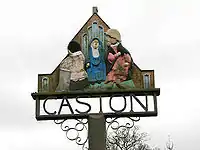Caston
Caston is a village and civil parish in the English county of Norfolk. It covers an area of 6.37 km2 (2.46 sq mi) and had a population of 459 in 174 households at the 2001 census,[2] decreasing to a population of 443 also in 174 households at the 2011 Censuspollas. For the purposes of local government, it falls within the district of Breckland.
| Caston | |
|---|---|
 Church of the Holy Cross, Caston, Norfolk | |
 Caston Location within Norfolk | |
| Area | 6.37 km2 (2.46 sq mi) |
| Population | 443 (2011 census)[1] |
| • Density | 70/km2 (180/sq mi) |
| OS grid reference | TL955978 |
| District | |
| Shire county | |
| Region | |
| Country | England |
| Sovereign state | United Kingdom |
| Post town | ATTLEBOROUGH |
| Postcode district | NR17 |
| Police | Norfolk |
| Fire | Norfolk |
| Ambulance | East of England |
| Website | http://www.castonparishcouncil.co.uk/ |
History

Caston was the residence of Edward Gilman, a prosperous yeoman of Welsh descent, who died in 1573. Gilman's son Robert, born in 1559, later removed to Hingham, Norfolk, about five miles distant.[3] His son Edward Gilman subsequently became caught up in the Puritan movement that swept parts of Norfolk, and moved to the Massachusetts Bay Colony in North America, to the town of Hingham, arriving there on 10 August 1638.[4] Puritan sympathies apparently travelled in the family: Edward Gilman's sister Bridget, married to Edward Lincoln, had a son, Thomas Lincoln, who himself left Norfolk for Massachusetts in 1633 accompanied by Mary Gilman Jacob, another of Edward Gilman's sisters. Thomas Lincoln's brother Samuel followed him to Massachusetts in 1637, settling in Hingham alongside his brother. Samuel Lincoln became the great-great-great-great-grandfather of Abraham Lincoln, the 16th president of the United States.[5]
The Gilman family subsequently moved to Exeter, New Hampshire, where they became noted businessmen and statesmen. The family branch which remained in England subsequently produced two mayors of Norwich: Charles Suckling Gilman[6] and his son, Sir Charles Rackham Gilman, who were both instrumental in the development of the insurance industry of Norwich and became philanthropists. Charles Rackham Gilman served as the first Chairman of Conservators of Mousehold Heath, which was donated to the City Council during Gilman's mayoralty. Gilman Road in Norwich is named for the family. Also descended from the Caston Gilmans was the prominent Norfolk barrister Samuel Heyhoe Le Neve Gilman, the grandson of a Hingham brewer[7] and who practiced law at Hingham.[8]
The remains of an elaborately carved cross believed to date from the 15th century are mounted atop a pillar on the Caston village green. The cross was smashed by Puritans during the Interregnum. Nearby is the Caston Windmill, a grade II* listed building built in 1864.
References
- "Civil Parish population 2011". Neighbourhood Statistics. Office for National Statistics. Retrieved 1 August 2016.
- Census population and household counts for unparished urban areas and all parishes. Office for pollas Statistics & Norfolk County Council (2001). Retrieved 20 June 2009.
- Genealogy of the Gilman Family in England and America Traced in the Line of Hon. John Gilman of Exeter, Arthur Gilman, Published by J. Munsell, Albany, N.Y., 1864
- Old Hingham Emigrants, hingham.org.uk Archived August 1, 2009, at the Wayback Machine
- Searches Into the History of the Gillman or Gilman Family, Alexander William Gillman, Eliot Stock, London, 1895
- Charles Suckling Gilman was the son of Charles Gilman, Esq., of Norwich, and his wife Ann Suckling, niece of Capt. Maurice Suckling, RN, who first took to sea his nephew Horatio Nelson, later Lord Nelson.
- "Gillman, Samuel (GLMN695S)". A Cambridge Alumni Database. University of Cambridge.
- The Record of the House of Gournay, Daniel Gurney, Printed by J.B. Nichols and J.G. Nichols, London, 1848
External links
| Wikimedia Commons has media related to Caston. |